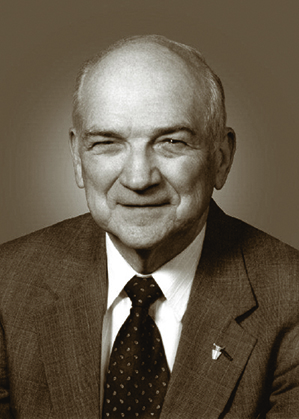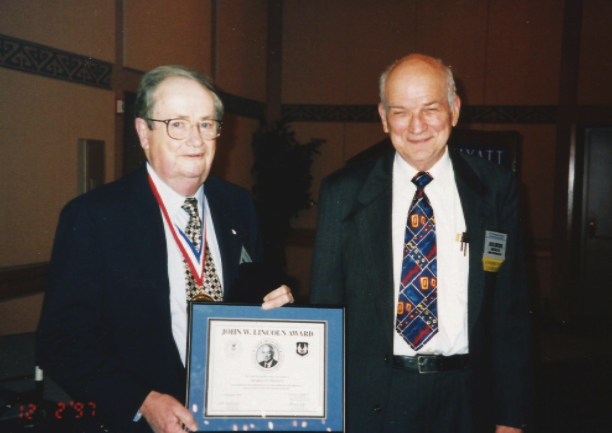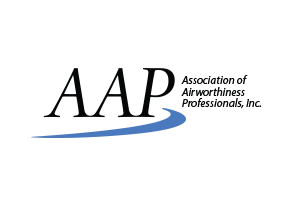Dr. John (Jack) W. Lincoln, Ph.D., P.E. 1928 - 2002
The Accomplishments of Dr. John (Jack) W. Lincoln
Dr. John (Jack) W. Lincoln is still recognized internationally as an expert in structural integrity and a champion of aviation safety. From his early days as an aviator, piloting a DC-3 aircraft for his father's Dallas, Texas based "Lincoln Airlines," his contributions as Chief of Structures at Vought Aerospace, to his career with the United States Air Force (USAF), Dr. Lincoln was a pioneer in aerospace engineering.
Dr. Lincoln is credited with maturing the Aircraft Structural Integrity Program (ASIP) into a robust process that is now institutionalized within the Air Force and recognized worldwide as the model for ensuring aircraft structural airworthiness. The USAF’s unparalleled worldwide aircraft structural safety record since 1980 is directly attributable to Dr. Lincoln’s leadership in the field of structures technology.
In 1971, Dr. Lincoln brought 22 years of structural design experience from Vought Aerospace to the Aeronautical Systems Division (ASD) of the United States Air Force at Wright-Patterson Air Force Base and accumulated another 29 years of service to both military and commercial structural integrity processes over his distinguished career. Dr. Lincoln's initial assignment with the Air Force in 1971 was to direct an independent review of the C-5A aircraft. This work determined the structural modifications required to achieve the originally planned service life for this aircraft. For his outstanding contributions in this area, Dr. Lincoln was awarded the 1973 USAF Meritorious Civilian Service Medal. During his career in the Air Force, he has influenced the design of many aircraft including the C-5B, B-1B, F-15E, F-16, T-46, C-17, F-22 and Joint Strike Fighter.
As a Technical Expert and then Technical Advisor for Engineering, he directed the execution of damage tolerance assessments for many of the USAF major aircraft weapon systems. This effort defined the inspection, maintenance, repair and modification programs required to maintain flight safety of each of these aircraft. Dr. Lincoln participated in a multitude of engine damage tolerance assessments and was the driving force behind development of the damage tolerance approach for Air Force helicopters.
Dr. Lincoln worked tirelessly with leaders in the military and commercial aerospace technology arena and developed industry standards for transition of new structural technologies to full-scale development. He served as an advisor and principal participant in ad hoc panels of the United States Air Force Scientific Advisory Board addressing structural integrity issues on systems including the C-5A, KC-135, C-130 and the C-141.
In the interest of commercial aviation safety and the advancement of damage tolerance principles, he worked extensively with the Federal Aviation Administration (FAA), acting in a capacity as a senior technical advisor. Dr. Lincoln's affiliation with and contributions to the FAA spanned many years. For example, in 1979 at the request of the FAA, he led the damage tolerance assessment by Douglas Aircraft Company of the DC-10 pylon following the crash of a DC-10 at Chicago, Illinois. His findings and recommendations permitted the FAA to identify the cause of failure and institute a maintenance program that would preclude a reoccurrence of this problem in the future.
Dr. Lincoln was an active member of the FAA sponsored Technical Oversight Group on Aging Aircraft (TOGAA). This group was charged with examining the problems of aging in the commercial fleet and advised the FAA on design and maintenance actions required for aircraft ranging from small commuter class to large transports. Dr. Lincoln drafted rules for the application of damage tolerance to commuter aircraft design. As a part of the effort with TOGAA, he has established guidelines for the continued airworthiness of commuter class aircraft.
USAF Career Highlights
In 1972, amidst significant public debate over structural shortfalls in the Air Force's newest transport aircraft, the C-5A Galaxy, Lieutenant General Stewart, commander of the Aeronautical Systems Division, requested that Dr. Lincoln lead an Independent Review Team (IRT) for that program. The IRT was a major challenge since the hundred people composing the independent team, recruited from all over the United States and the United Kingdom, had no previous experience with this aircraft. Further, damage tolerance procedures were developed and applied to the C-5A by the IRT under the direction of Dr. Lincoln, the first application of these procedures to a transport aircraft and thus formed the basis for future aircraft damage tolerance assessments undertaken by the USAF. The culmination of this one-year effort included a briefing by Dr. Lincoln to the Secretary of the Air Force where he successfully championed the IRT recommendations for the C-5A program modifications.
In a follow-on evaluation in 1979, Dr. Lincoln chaired the C-5A Structural Information Enhancement Program. Dr. Lincoln pioneered a new application of aircraft inspection data, structural testing and fail-safe analysis in the use probabilistic software he developed to perform a risk analysis and made projections for the onset of widespread fatigue damage in the fleet. The results of his evaluation permitted the Air Force to continue safe operations with limitations until wing replacements could be implemented. Dr. Lincoln's impact on this system survives today with the decision to extend the operational life of the C-5A by another 20 years.
During the period from 1975 to 1990, he directed the damage tolerance assessments of many of the major weapon system in the USAF inventory. These efforts involved all major aerospace manufacturers and included multidiscipline structural analysis representing over a million man-hours of work. In addition to providing the Air Force critical information on operational utility, this effort defined and implemented individual aircraft tracking programs based on damage tolerance principles. This approach to fleet management is a mainstay in Air Force aircraft fleet management and a principal basis for the operational safety record enjoyed by the USAF. The work performed by Dr. Lincoln during this period made possible a significant life extension program for the KC-135 and provided critical information in the decision to perform major upgrade modifications on the C-141 and B-52 programs. Dr. Lincoln served as a member of the steering group for damage tolerance assessments of the F100 and TF34 engines. These assessments were pioneering efforts that established the procedures for many engine damage tolerance assessments that followed in both the military and commercial worlds.
He served as chairperson of the F-15 Structural Review Committee. This committee investigated the cause of an in-flight wing failure from overload and provided oversight on activities relating to fatigue problems on the vertical tail and wing. This activity led to the development and implementation of damage tolerance criteria on the F-15 and resolution of the F-15 buffet issues that had caused numerous failures in the vertical tail.
In 1986, he led an independent review of the T-37 aircraft to determine the modifications needed to permit this aircraft to remain in operational service for an additional fifteen years. Again, he applied the probabilistic methods he had developed in a risk assessment of the aircraft structure, permitting continued fleet operations with provisions for inspections.
He served as chairperson of a review team in 1988 to assess the impact of a full-scale static test failure of the F-16 wing. Performing a risk assessment of the aircraft based on data from operational aircraft, he provided rationale for a redesign to restore the aircraft to its original static strength requirement.
He served on a National Aeronautics and Space Administrative (NASA) committee for the certification of hypersonic vehicles. This activity led to the establishment of a specification for a facility to perform hypersonic testing of aircraft such as the National Aerospace Plane. It also served to introduce damage tolerance requirements in the design of spacecraft.
In response to a 1990 request from Mr. Jack Welch, Secretary of the Air Force for Acquisition, he performed an independent study on the structural modification program for the F-16 aircraft. This effort was difficult because of the early cracking of aircraft that had seen operational usage approximately eight times more severe than the design usage. This effort provided senior Air Force leadership with the assurance that the aircraft needed these modifications and also gave them an independent assessment of the costs of implementing them.
In response to a 1991 request from Major General Gillis, Commander of the Warner Robins Air Logistics Center, Dr. Lincoln performed a risk assessment of the C-141 structural wing containing multi-site fatigue damage type cracking. Dr. Lincoln’s risk assessment involved the assessment of the airworthiness of cracked (a) span-wise splices, (b) wing plank weep holes and (c) multiple critical structural frames. His analysis identified repair, replacement and inspection options for maintaining the safety of the C-141 aircraft during the Desert Shield/Desert Storm conflict and permitted the full operational capability of the aircraft to be used. He briefed his findings to General Johnson, Commander of the Air Mobility Command, which resulted in an extensive inspection program. In a follow-on Scientific Advisory Board Review, Dr. Lincoln's recommendations on implementation of recently developed composite patching of the wing skins on the C-141 were accepted and the fleet was restored to full operational capability. Without Dr. Lincoln’s efforts, the complete C-141 fleet would have been grounded. Subsequently, Dr. Lincoln responded to a request by the Department of Defense (DOD), and conducted an independent assessment of the remaining life of the C-141 aircraft. His findings and recommendations were used in the decision to press forward with the development of the C-17 as a future replacement aircraft.
At the request of Lieutenant General Fain in 1992, he served as leader of the USAF team working with the US Navy to develop the Joint Structures Specification Guide. These criteria served as the principal guidance for contemporary USAF and Navy aircraft design. He was the Senior Civilian Participant in an USAF Scientific Advisory Board Summer Study in 1994; tenets developed by Dr. Lincoln were briefed to the Chief of Staff and served as the basis for aging aircraft research and development.
At the request on Major General Franklin, Program Executive Officer (PEO) for the C-17, he acted as senior advisor in the executive independent review of the C-17 test wing failure that occurred in 1992. He briefed his findings and recommendations to Secretary of the Air Force and the Chief of Staff. His input and the work of this committee outlined a recovery plan that resulted in the successful retest of a modified wing.
In 1995 he chaired an independent review team assessment of F-16 service life. The review determined actions required to ensure that the aircraft could reach its 8,000-life goal. Included was a recovery action for the significant cracking being experienced in the fuselage bulkhead that supports the vertical tail.
Contributions to Commercial and International Aviation
At the request of the FAA, Dr. Lincoln performed an independent assessment of the Boeing 747 structure in 1987. His evaluation led to a series of detailed inspections of the aircraft in prescribed locations. In 1979 he oversaw the damage tolerance assessment performed on the DC-10 engine pylon following the mishap of a DC-10 in Chicago, Illinois. Dr. Lincoln served as a tenured member of the TOGAA chartered by the FAA after the highly publicized 1988 Aloha Airlines incident. Dr. Lincoln's work in this group focused on issues of widespread fatigue damage in commercial aircraft. In support of the evaluation of the Aloha incident, Dr. Lincoln helped formulate the Airworthiness Directives permitting safe operations of both the 737 and the 727. In 1990, following the in-flight structural failure of the DC-10 engine resulting in the mishap at Sioux City, Iowa, he was called on for his technical expertise in the development of a recovery plan for the material issue that contributed to the engine disc failure.
As a senior technical advisor with the TOGAA, Dr. Lincoln advised the FAA on research and development initiatives related to aging commercial aircraft. His interaction with researchers at Iowa State University, Wayne State University, The Johns Hopkins University, Northwestern University and Sandia National Laboratory resulted in significant technological gains in the area of non-destructive inspection techniques. He wrote the Advisory Circular for the FAA Administrator for Certification and Regulation, which serves as the standard for the structural integrity of commuter class aircraft operated in the United States. His technical expertise was key in the development of a recovery program for the hard alpha problem, which is a material contamination issue in the titanium engine disc, that caused the crash of the DC-10 at Sioux City, Iowa.
Starting in 1990, Dr. Lincoln figured prominently in the work of the International Committee on Fatigue (ICAF), presenting papers recognized internationally for their contribution to aircraft structural integrity. In this forum, he shared his extensive knowledge of aircraft damage tolerance, probabilistic methods, technology transition, widespread fatigue damage in aircraft, full-scale aircraft structural testing and aircraft repair concepts. He has been acknowledged as an international expert in his field by aircraft structural experts from Australia, Canada, France, Germany, Israel, Italy, Japan, The Netherlands, Sweden, Switzerland, the United Kingdom, and the United States. In 1997, Dr. Lincoln was awarded the F.J. Plantema Award, the highest international honor for contributions for solving structural fatigue issues, by unanimous vote of the delegates of those nations forming the ICAF, and he was the plenary speaker at their conference.
He was a member of The Technical Cooperation Program (TTCP) AER-TP4 Panel Structures and Structural Dynamics and MAT-TP8 Panel on Composite Materials. The TTCP is a cooperative program among Australia, Canada, New Zealand, the United Kingdom, and the United States. In this capacity, he has acted as the principal contributor to specifications for the use of composites in aircraft structures.
He was a prominent member of the North Atlantic Treaty Organization (NATO), Advisory Group for Aerospace Research and Development (AGARD) and later RTO Advanced Vehicles Technology Panel. He presented his works on probabilistic methods and structural integrity to international experts in Lindau, Germany, Bath, United Kingdom, Bordeaux, France, and Rotterdam, the Netherlands. At the request of the FAA and NASA, he was a long-standing member of the organizing committee of FAA/NASA international meetings forum.
Beginning in 1984, Dr. Lincoln served as chairperson of the annual Aircraft Structural Integrity Program Conference and as host to domestic and international aerospace experts promoting military and commercial aircraft structural integrity. In 1996, Dr. Lincoln was recognized for his lifelong contributions during the annual international ASIP conference by being selected as the first recipient of the Dr. John W. Lincoln Award. This record is spectacular in view of the fact that many of the aircraft in the USAF inventory have flown safely well beyond their original design service life and continue to meet the United States' vital military missions.
The South Korean government solicited Dr. Lincoln’s assistance in 1995 in assessing the viability of their new trainer. He proposed and the government adopted his recommendations on structural integrity actions. Also in 1995, Israeli Air Force (IAF) requested Dr. Lincoln's support in addressing several structural issues with aircraft mechanical systems. His recommendations led to a cooperative USAF/IAF development program that substantially enhanced mechanical system integrity.
Summary
Dr. Lincoln was a highly respected engineer, recognized both nationally and internationally, for his outstanding knowledge of structural technologies and probabilistic risk assessment methods for ensuring aircraft airworthiness. His legacy as a pioneer in the field of structural integrity and damage tolerance has undoubtedly made a significant contribution to the continuing airworthiness and safety of military and commercial fixed and rotary wing aircraft and engines. Dr. Lincoln influenced foreign and domestic commercial and military aircraft development through industrial and/or governmental agency representatives and through organizations such as NATO, TTCP, ICAF and the FAA.
He was a leader in his field and a mentor to aspiring young engineers and maintenance personnel. Through his vision, demeanor and leadership he guided and greatly influenced the design and maintenance philosophy of today's aircraft. In particular, his technical expertise was critical to the development of maintenance policies and operation of United States Air Force aircraft. Dr. Lincoln's enduring legacy continues to advance the engineering sciences that are essential to prolonging the safe operational life of our military fleet of air vehicles. In his work in both commercial and government sectors, he made substantial contributions to the structural integrity of over fifty-five aircraft and missiles.
Dr. Lincoln was internationally recognized for his work in structural integrity and probabilistic risk assessment methods. In 2005, the revision of the Department of Defense’s MIL-STD-1530C (ASIP) incorporated Dr. Lincoln’s probabilistic risk assessment concepts and criteria so that his approaches would be promulgated and provide direction to those responsible for ensuring the initial and continuing airworthiness of aircraft and missile structures.
Thanks to Dr. Lincoln’s influence, the area of Structural Fatigue and Risk Analysis techniques, the USAF’s record of structural failures in flight has gone to near zero. This has also translated into near zero structural failures in flight in the commercial world, even though some of the aircraft are well over 60 years old and are still flying revenue passengers. Finally, even though Dr. Lincoln’s work has been in the aircraft structures, it has seen global applications in areas such as trucks and cars.

Dr. John (Jack) W. Lincoln

Dr. Lincoln Presenting the Lincoln Award to Chuck Tiffany (1997)
Previous Lincoln Award Winners
| Year | Lincoln Award Winners |
|---|---|
| 2023 | Mr. Chris Maddox |
| 2022 | Dr. Lawrence M. Butkus |
| 2021 | Dr. Dale L. Ball |
| 2020 | Delayed Until 2021 |
| 2019 | Mr. Ko-Wei Liu |
| 2018 | Dr. Robert "Bob" J. Bucci |
| 2017 | Mr. Robert J. Burt |
| 2016 | Dr. Anders Blom |
| 2015 | Mr. Ed Ingram |
| 2014 | Mr. Larry Perkins |
| 2013 | Dr. Thomas R. Brussat |
| 2012 | Mr. James L. Rudd |
| 2011 | Mr. Len Reid |
| 2010 | Professor Graham Clark |
| 2009 | Mr. Robert M. Bader |
| 2008 | Dr. Joseph P. Gallagher |
| 2007 | Dr. Alan P. Berens |
| 2006 | Dr. Ulf G. Goranson |
| 2005 | Mr. Charles R. Saff |
| 2004 | Mr. Robert Bell |
| 2003 | Mr. Ward Rummel |
| 2002 | Mr. Royce Forman |
| 2001 | Prof. James C. Newman, Jr. |
| 2000 | Prof. Alten Grandt, Jr. |
| 1999 | Prof. Jaap Schijve |
| 1998 | Mr. Thomas Swift |
| 1997 | Mr. Charles F. Tiffany |
| 1996 | Dr. John W. Lincoln |


